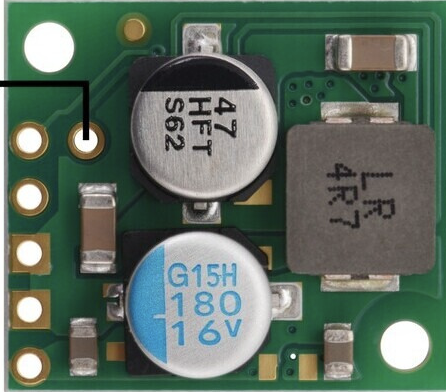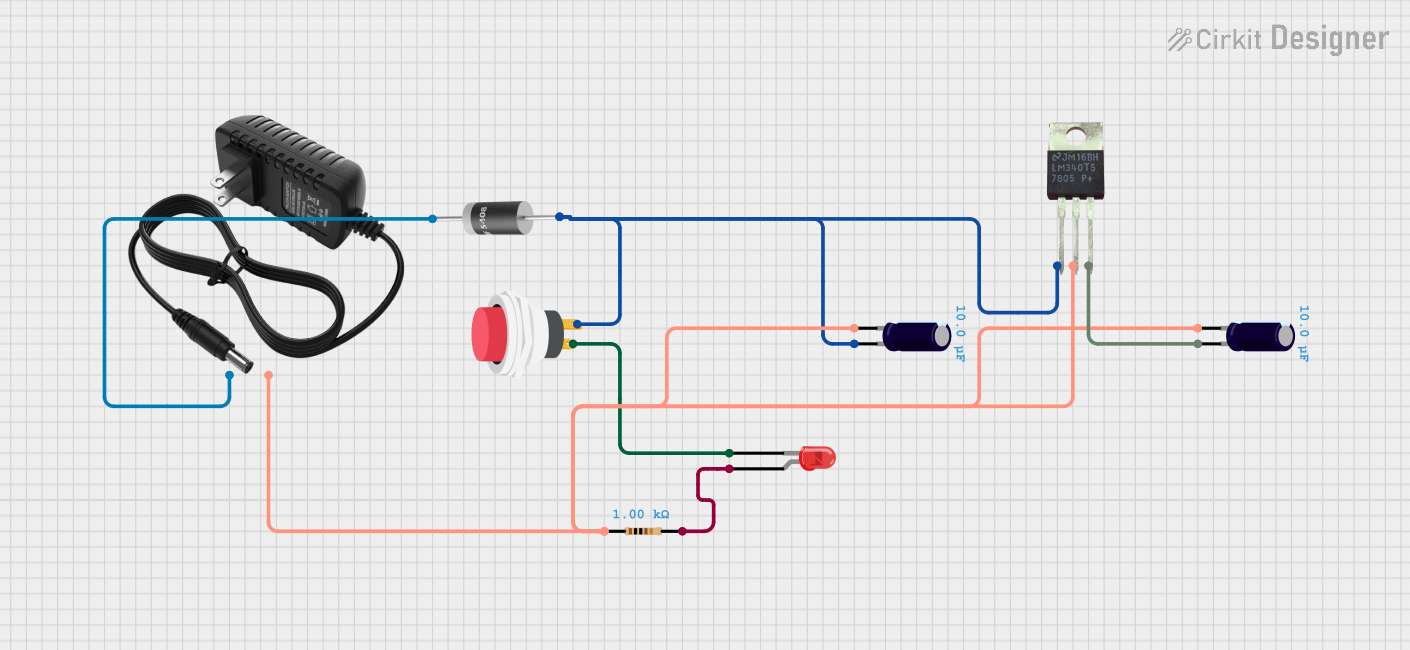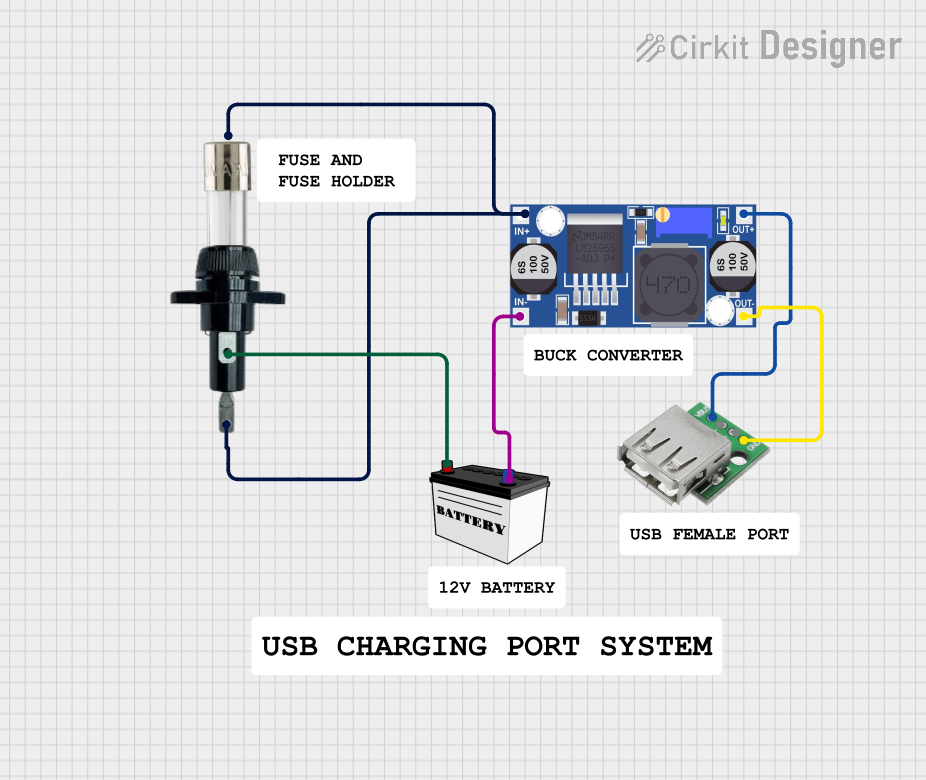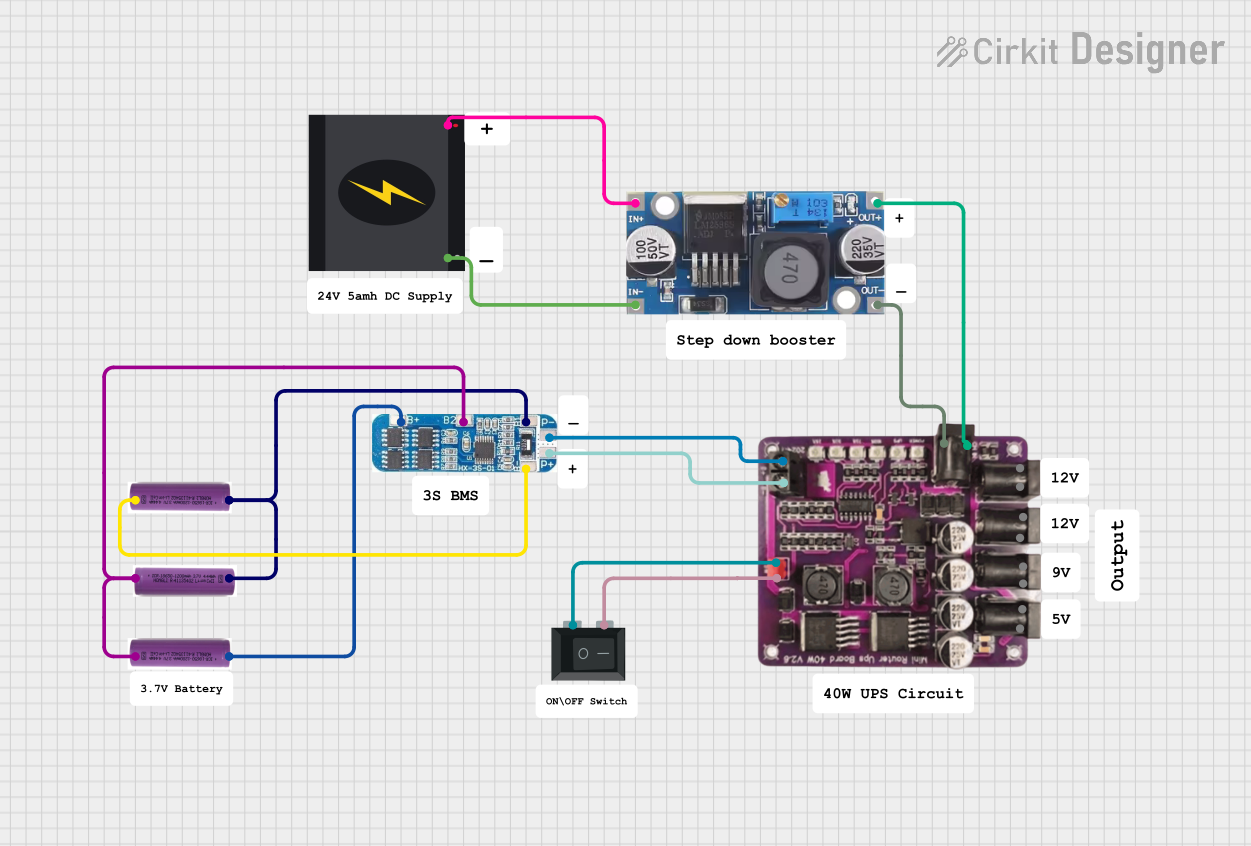
How to Use 5V, 3.4A Step-Down Voltage Regulator: Examples, Pinouts, and Specs

 Design with 5V, 3.4A Step-Down Voltage Regulator in Cirkit Designer
Design with 5V, 3.4A Step-Down Voltage Regulator in Cirkit DesignerPololu D30V30F5 5V, 3.4A Step-Down Voltage Regulator Documentation
1. Introduction
The Pololu D30V30F5 is a high-efficiency step-down voltage regulator designed to convert a higher input voltage into a stable 5V output. With a maximum output current of 3.4A, this regulator is ideal for powering low-voltage devices such as microcontrollers, sensors, and other electronics from higher voltage sources like batteries or power supplies.
This compact and reliable regulator is widely used in applications such as:
- Robotics and automation systems
- Battery-powered devices
- Arduino and microcontroller-based projects
- Portable electronics
- LED lighting systems
The D30V30F5 is designed to handle input voltages ranging from 6V to 50V, making it versatile for a wide range of power supply configurations.
2. Technical Specifications
Key Technical Details
| Parameter | Value |
|---|---|
| Input Voltage Range | 6V to 50V |
| Output Voltage | 5V ± 4% |
| Maximum Output Current | 3.4A |
| Efficiency | Up to 90% (depending on load) |
| Quiescent Current | ~1 mA |
| Switching Frequency | ~470 kHz |
| Operating Temperature | -40°C to +85°C |
| Dimensions | 0.7" × 0.8" × 0.3" (18 × 20 × 8 mm) |
| Weight | 1.5 g |
Pin Configuration and Descriptions
| Pin Name | Pin Type | Description |
|---|---|---|
| VIN | Input | Connect to the positive terminal of the input voltage source (6V to 50V). |
| GND | Ground | Connect to the ground of the input and output circuits. |
| VOUT | Output | Provides a regulated 5V output. Connect to the load requiring 5V power. |
| ENABLE | Input | Optional pin to enable or disable the regulator. Pull high to enable (default). |
3. Usage Instructions
Connecting the Regulator in a Circuit
- Input Voltage Source: Connect the VIN pin to the positive terminal of your input voltage source (e.g., a 12V battery or power supply). Ensure the input voltage is within the 6V to 50V range.
- Ground Connection: Connect the GND pin to the ground of your input voltage source and the ground of your load circuit.
- Output Voltage: Connect the VOUT pin to the positive terminal of your load circuit. Ensure the load does not exceed the maximum current rating of 3.4A.
- Enable Pin (Optional): If you wish to control the regulator's operation, connect the ENABLE pin to a microcontroller or switch. Pull it high (default) to enable the regulator or low to disable it.
Important Considerations
- Heat Dissipation: At high currents, the regulator may generate heat. Ensure proper ventilation or use a heatsink if necessary.
- Input Voltage Range: Do not exceed the maximum input voltage of 50V, as this may damage the regulator.
- Capacitors: For optimal performance, use input and output capacitors close to the regulator. A 10 µF capacitor on both VIN and VOUT is recommended.
- Polarity: Ensure correct polarity when connecting the input and output terminals to avoid damage.
4. Example Application with Arduino UNO
The Pololu D30V30F5 can be used to power an Arduino UNO from a 12V battery. Below is an example circuit and Arduino code to demonstrate its usage.
Circuit Diagram
- Connect the VIN pin of the regulator to the positive terminal of a 12V battery.
- Connect the GND pin of the regulator to the ground of the battery and the Arduino UNO.
- Connect the VOUT pin of the regulator to the 5V pin of the Arduino UNO.
Arduino Code Example
// Example code to blink an LED connected to pin 13 of the Arduino UNO
// The Arduino UNO is powered by the Pololu D30V30F5 regulator
void setup() {
pinMode(13, OUTPUT); // Set pin 13 as an output pin
}
void loop() {
digitalWrite(13, HIGH); // Turn the LED on
delay(1000); // Wait for 1 second
digitalWrite(13, LOW); // Turn the LED off
delay(1000); // Wait for 1 second
}
5. Troubleshooting and FAQs
Common Issues and Solutions
| Issue | Possible Cause | Solution |
|---|---|---|
| Regulator not providing 5V output | Incorrect input voltage or polarity | Verify input voltage is within 6V to 50V and check polarity. |
| Regulator overheating | Excessive load current or poor ventilation | Reduce load current or improve airflow around the regulator. |
| Output voltage fluctuating | Insufficient input/output capacitors | Add a 10 µF capacitor to both VIN and VOUT pins. |
| Regulator not turning on | ENABLE pin pulled low | Ensure the ENABLE pin is pulled high or left unconnected (default is enabled). |
FAQs
Can I use this regulator with a 24V power supply?
- Yes, the regulator supports input voltages up to 50V, so 24V is within the acceptable range.
What happens if I exceed the 3.4A current limit?
- The regulator has built-in overcurrent protection. If the load exceeds 3.4A, the output may shut down or become unstable.
Can I use this regulator to power a Raspberry Pi?
- Yes, the 5V output and 3.4A current rating are sufficient to power a Raspberry Pi and its peripherals.
Is the regulator protected against reverse polarity?
- No, the regulator is not protected against reverse polarity. Ensure correct wiring to avoid damage.
6. Additional Resources
This documentation provides a comprehensive guide to using the Pololu D30V30F5 5V, 3.4A Step-Down Voltage Regulator. Whether you're a beginner or an experienced user, this guide will help you integrate the regulator into your projects effectively.
Explore Projects Built with 5V, 3.4A Step-Down Voltage Regulator

 Open Project in Cirkit Designer
Open Project in Cirkit Designer
 Open Project in Cirkit Designer
Open Project in Cirkit Designer
 Open Project in Cirkit Designer
Open Project in Cirkit Designer
 Open Project in Cirkit Designer
Open Project in Cirkit DesignerExplore Projects Built with 5V, 3.4A Step-Down Voltage Regulator

 Open Project in Cirkit Designer
Open Project in Cirkit Designer
 Open Project in Cirkit Designer
Open Project in Cirkit Designer
 Open Project in Cirkit Designer
Open Project in Cirkit Designer
 Open Project in Cirkit Designer
Open Project in Cirkit Designer